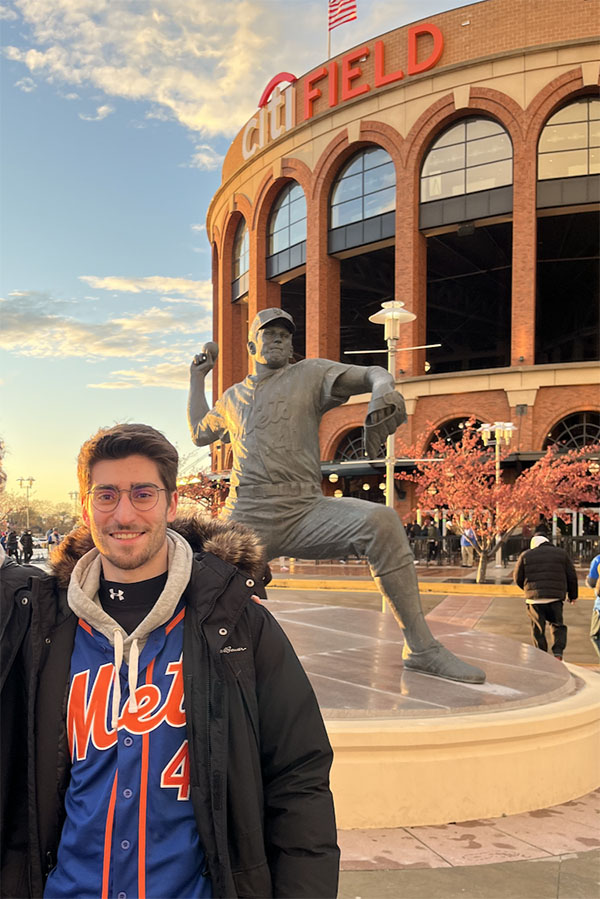The Economics of Baseball, Taylor Swift, and the American Dream
What do professional baseball, Taylor Swift’s Eras tour, and US immigration policy have in common?
At American University, they’ve all been the focus of popular economics classes designed by students. In these one-credit courses, undergrads explore economic concepts through real-world topics they care about most, whether that’s the business of baseball, the economic ripple effects of Taylor Swift, or the labor market impact of immigration.
The courses serve as a gateway to economics, showing undergrads that the field isn’t just abstract theory but a way to explore topics they care about in the real world. The idea grew out of a Student-Designed Course Competition, launched by the Department of Economics in January 2024. Each spring, it invites students to pitch course ideas, encouraging them to bring their fresh perspectives and personal interests into the field. Winning proposals are then developed into courses taught by economics faculty such as Professor Kara Reynolds.
"I think as faculty we get tied up with the issues that we think are important and sometimes forget that these might not be the same issues that students really care about,” Reynolds says. “Economics impacts so much of society, and the competition was designed to help the department discover what students want to know about the field.”
The Launch of Swiftonomics

It all began in fall 2024 with ECON 396: Swiftonomics: Economics of Taylor Swift, created by the first Student-Designed Course Competition winners Megan Wysocki ’26 and Mackenzie Shultz ’26. The class filled up fast. On day one, students received friendship bracelet kits—each one spelling out economic concepts like “demand” and “inflation.” From there, the class dove into the economic footprint of Swift and her record-breaking Eras Tour, exploring job creation, tourism, consumer behavior, media markets, entertainment monopolies, and more.
The course was an instant sensation—filling up fast and garnering national media attention in Newsweek, Billboard, Washingtonian, CNBC, NBC News, WTOP, and other major news outlets. Thanks to popular demand, it returned in spring 2025.
Real Data, Current Events and the Economics of Immigration
For economics and political science major Haider Zaidi, the goal of AU’s new Economics of Immigration course is simple: to make economics engaging and approachable. “Instead of teaching economics through abstract examples, we can focus on what’s happening in the world right now,” he says. “Immigration provides a concrete case to explore how labor supply affects wages and employment. From there, students can build up to broader topics such as capital and productivity, going beyond the theoretical.”
The course, designed by Zaidi, along with fellow undergraduates Isabella Gourley and Arjun Mishra, replaces last year’s Swiftonomics and requires no prerequisites. By grounding lessons in real data and current events—including US immigration policies making headlines now—students examine immigration’s impact on labor and housing markets, crime rates, economic growth, public finance, and more. They also compare immigration systems worldwide and explore how policies shape outcomes for immigrants, their home countries, and their destinations.
Zaidi hopes the class sparks a wider interest in economics: “We want students to see that economics isn’t just endless graphs and numbers—it’s a real-world lens on the issues shaping our everyday lives.”
Coming This Spring: The Business of Baseball
Next spring, students can look forward to studying American’s favorite pastime: baseball. Baseball Economics was designed by Luke Fiore, an advanced economics PhD with a lot of baseball experience—he worked for the Topps Company (and Fanatics, after they acquired Topps) for four years and interned with the New York Yankees during his time as an undergraduate student at Fordham University.

Fiore will teach Baseball Economics with faculty mentorship, encouraging students to explore America’s pastime through the lens of economics. “During my first two years as an economics PhD student, I constantly found myself relating the material discussed across all of my classes back to baseball,” he says. “Once I was assigned to TA last year’s Swiftonomics course, I saw what was possible in designing a one-credit course and really started to organize my thoughts. Ultimately, I think Baseball Economics will be a fun way for any undergraduate economics student, not just baseball fans, to use baseball to begin thinking critically about important economic concepts with broader real-world implications.”
In the course, students will discuss the division of profits between players and ownership, as well as the impact of the inequalities between player salaries and between team resources and competitiveness, before comparing the baseball market to alternative systems like the European soccer model. Ultimately, Fiore says, students are encouraged to think open-mindedly and critically about their beloved game through economic analysis.
Learn More!
Economics students can look for more information on submitting their own course when the competition launches this January. Students interested in registering for the spring 2026 Baseball Economics can find it in the schedule of classes under ECON-396.